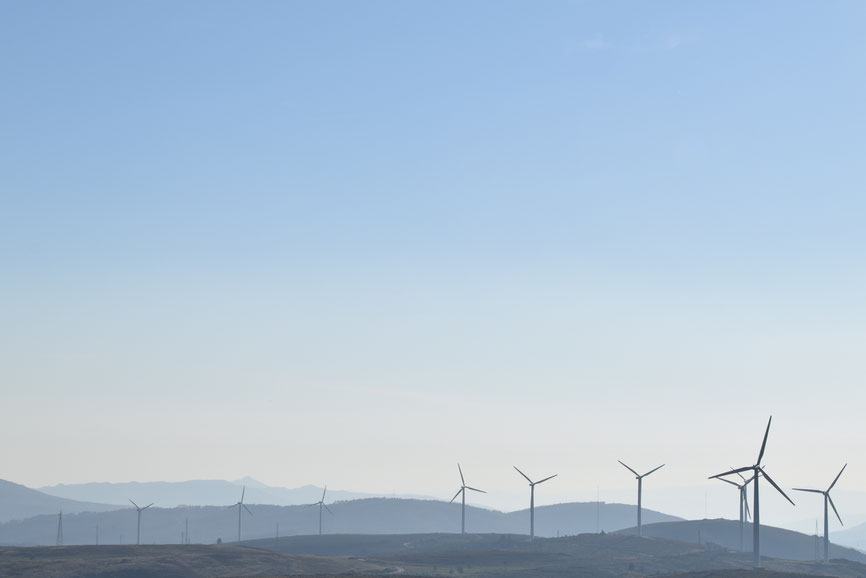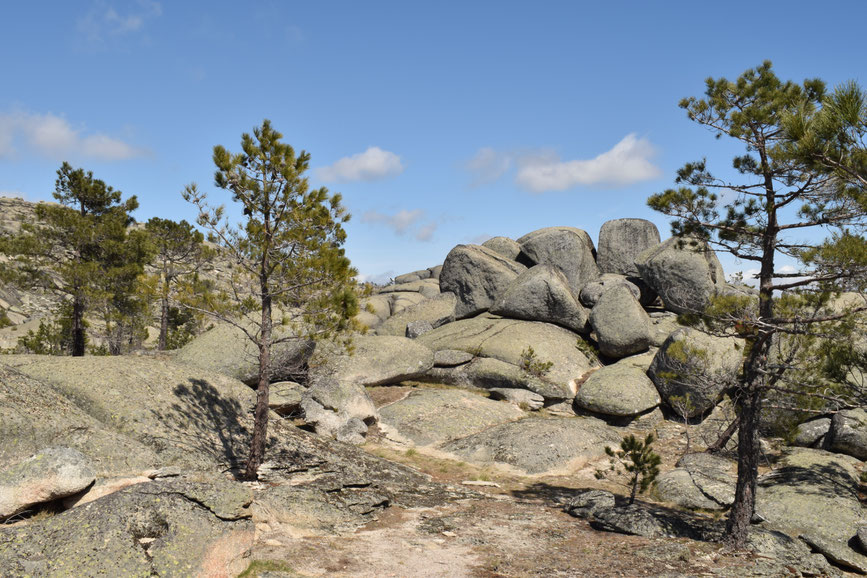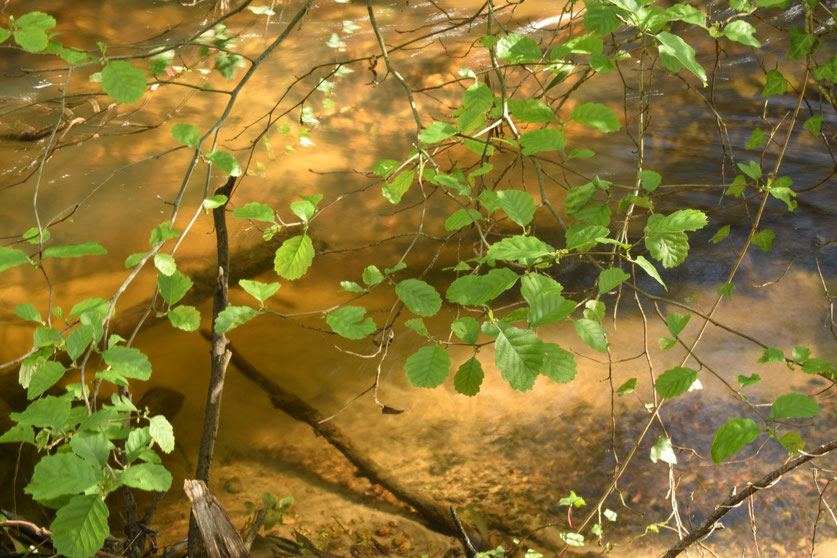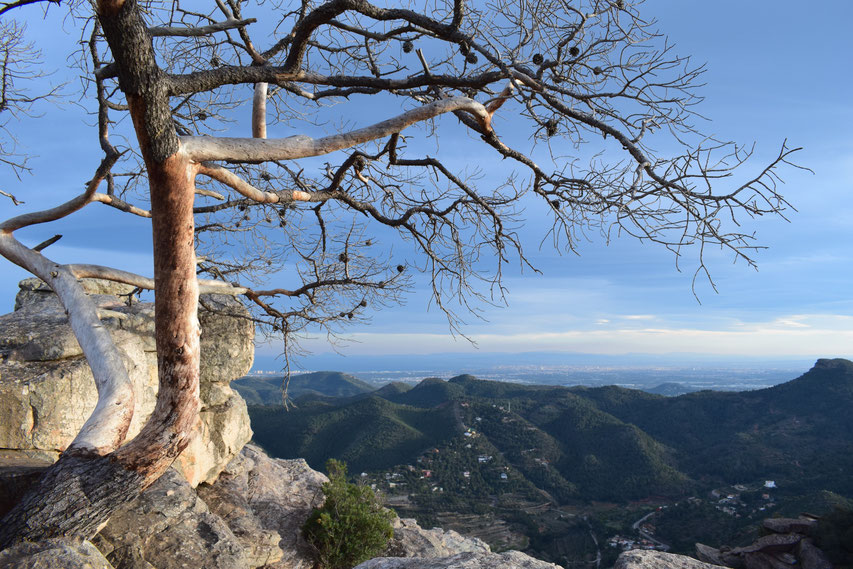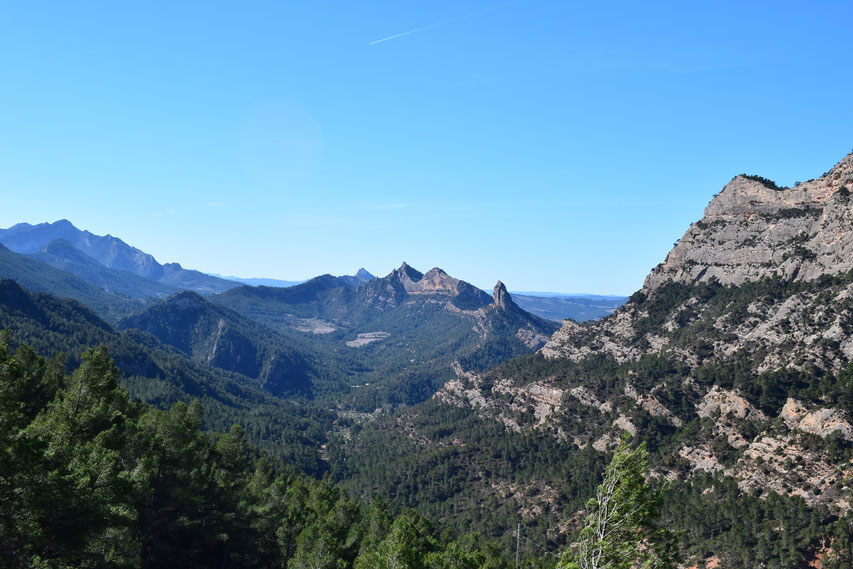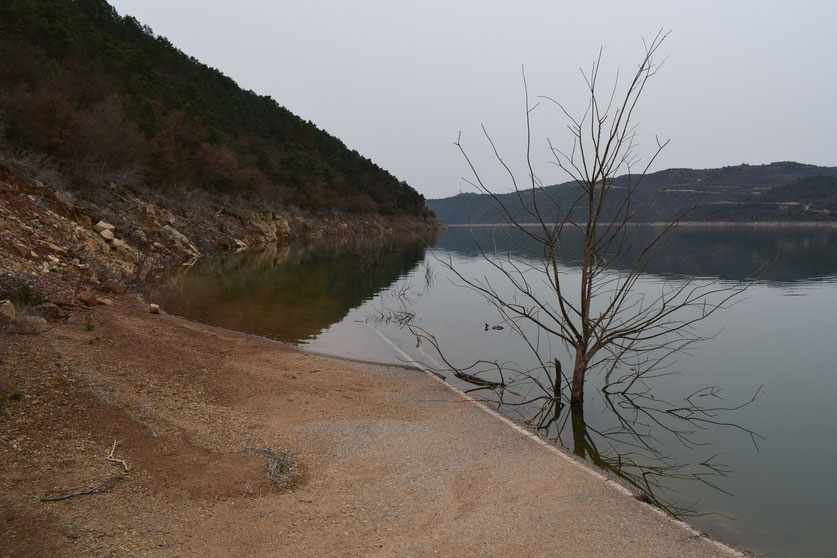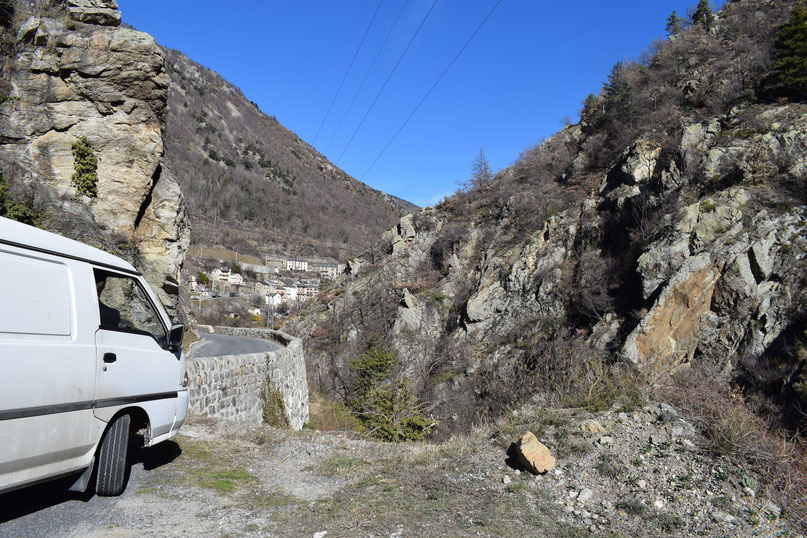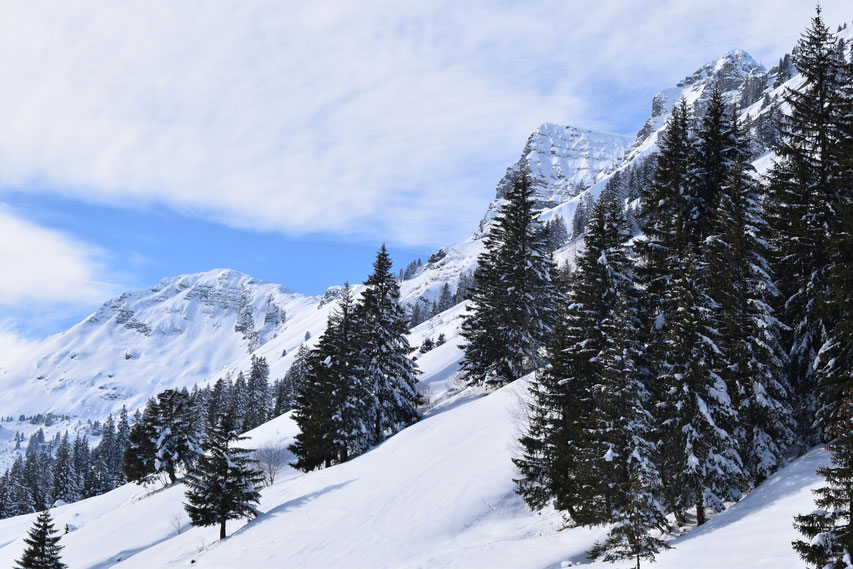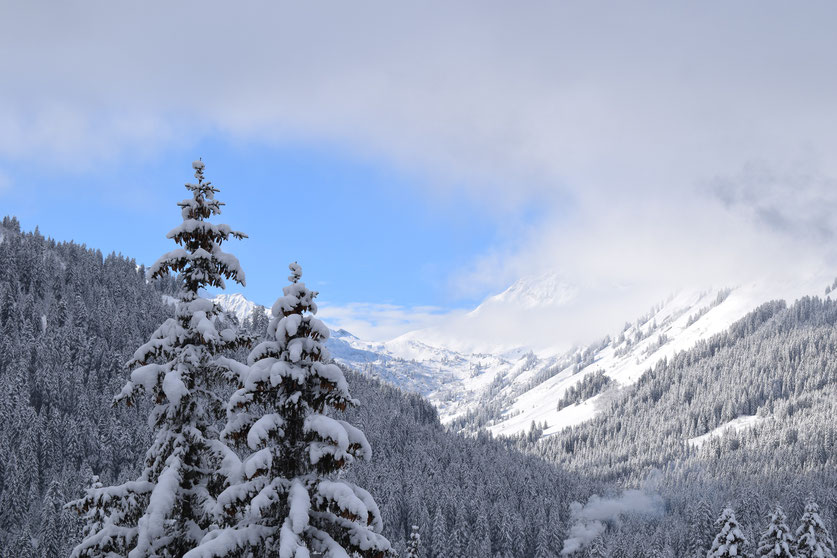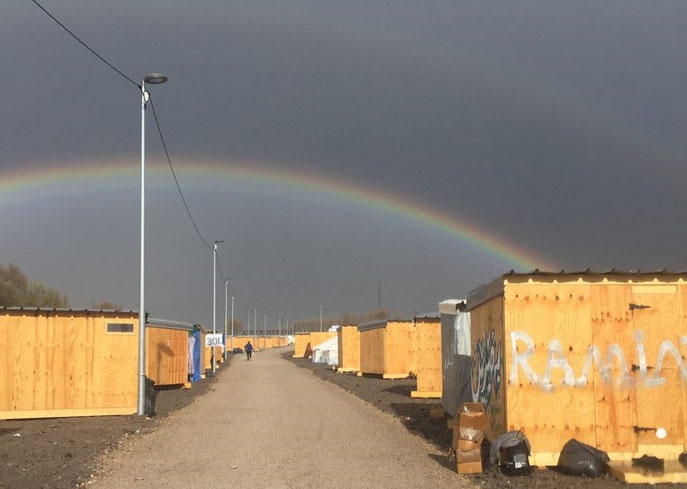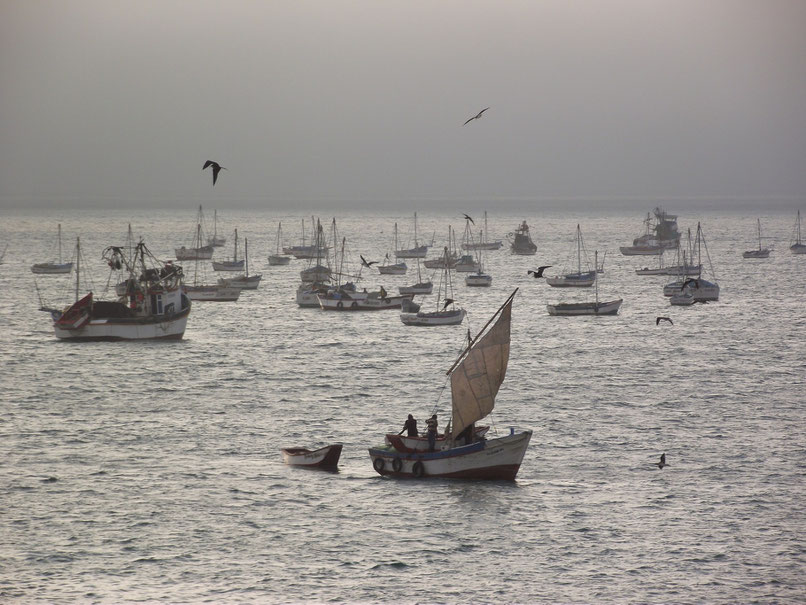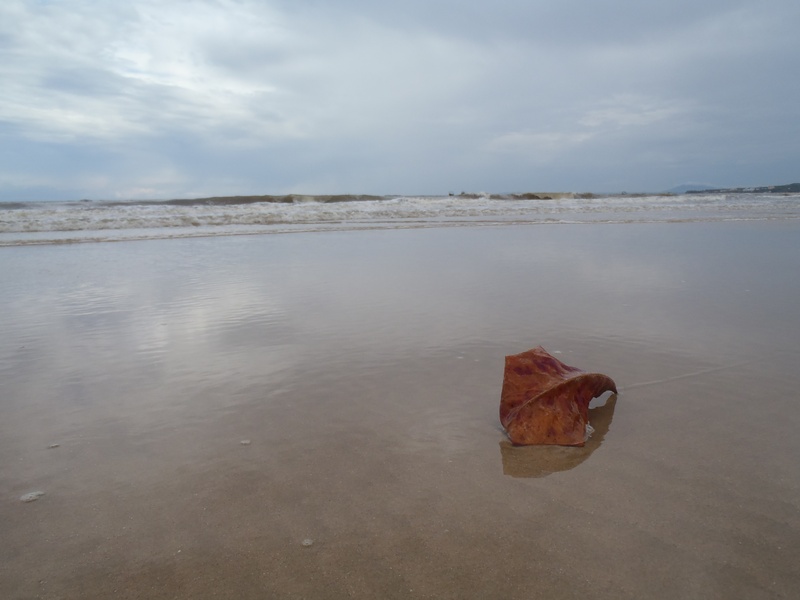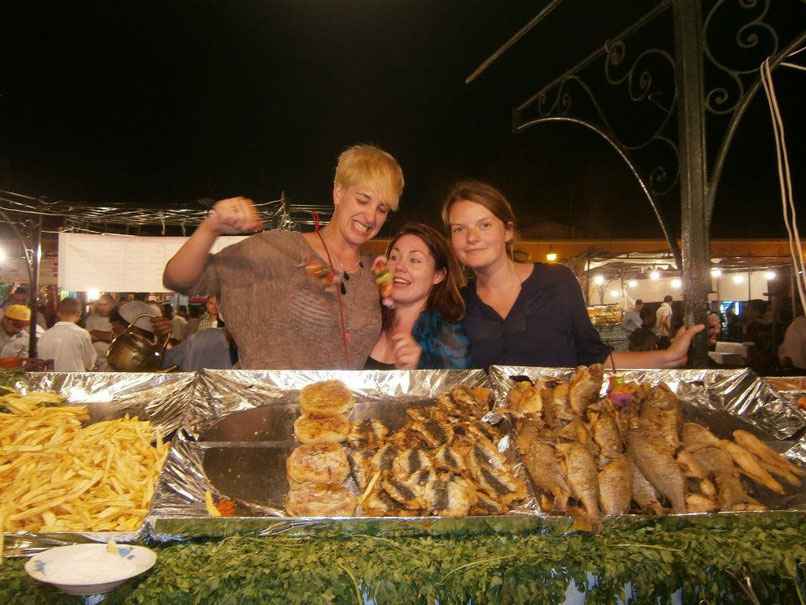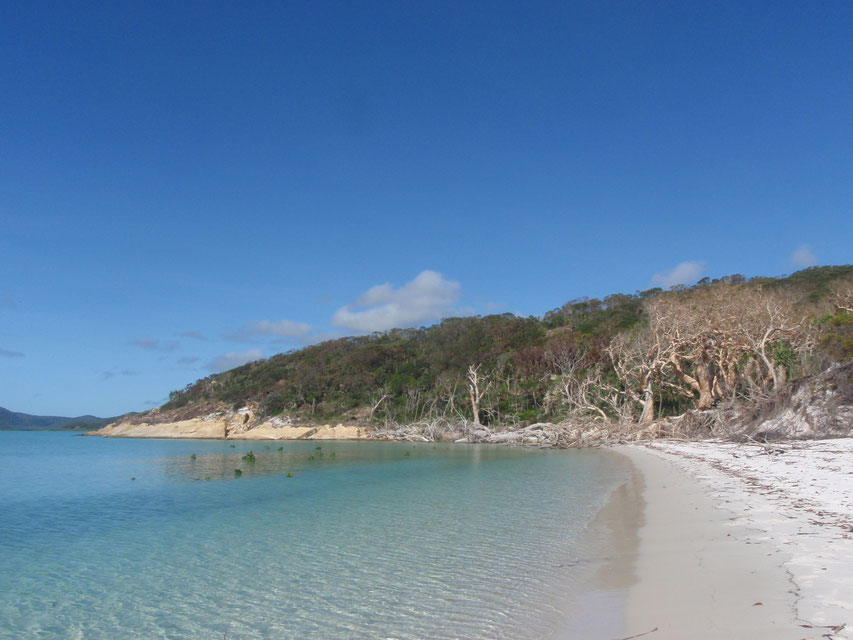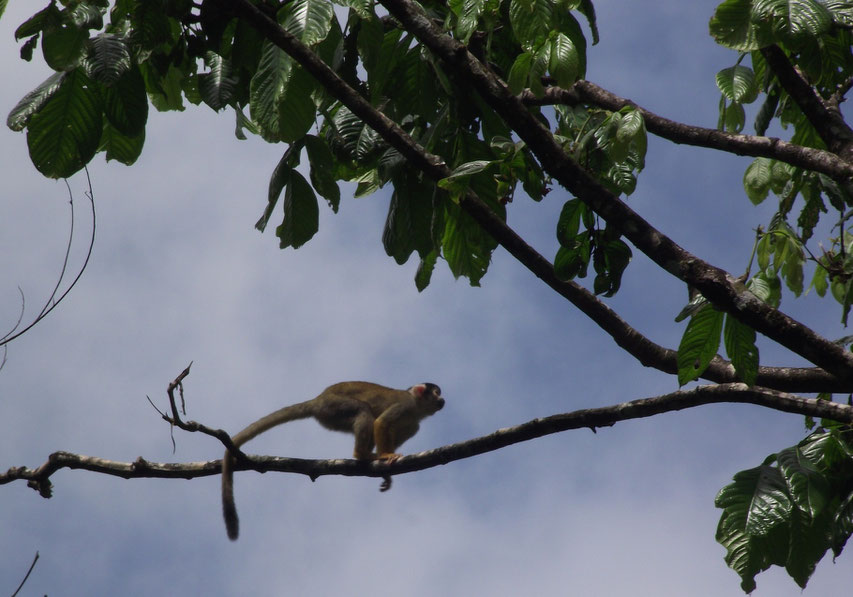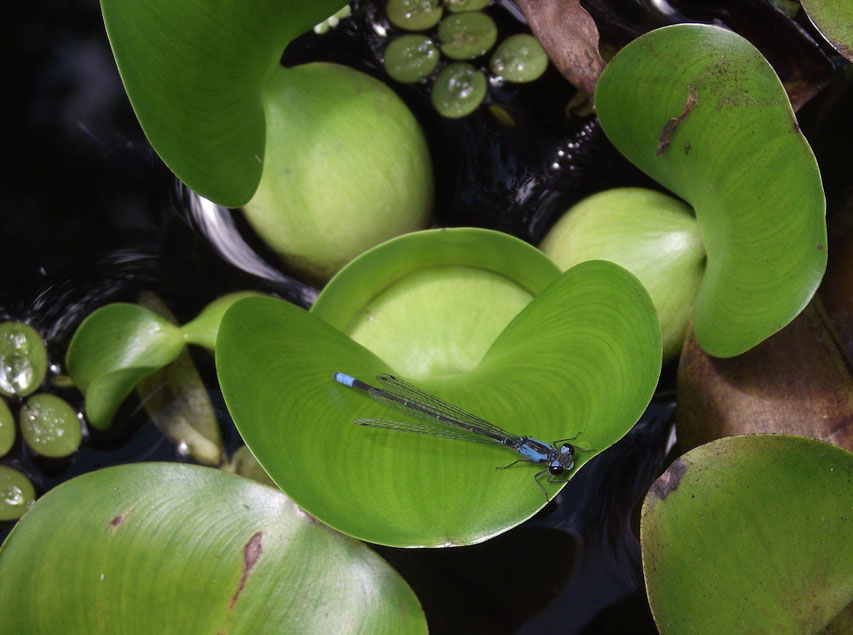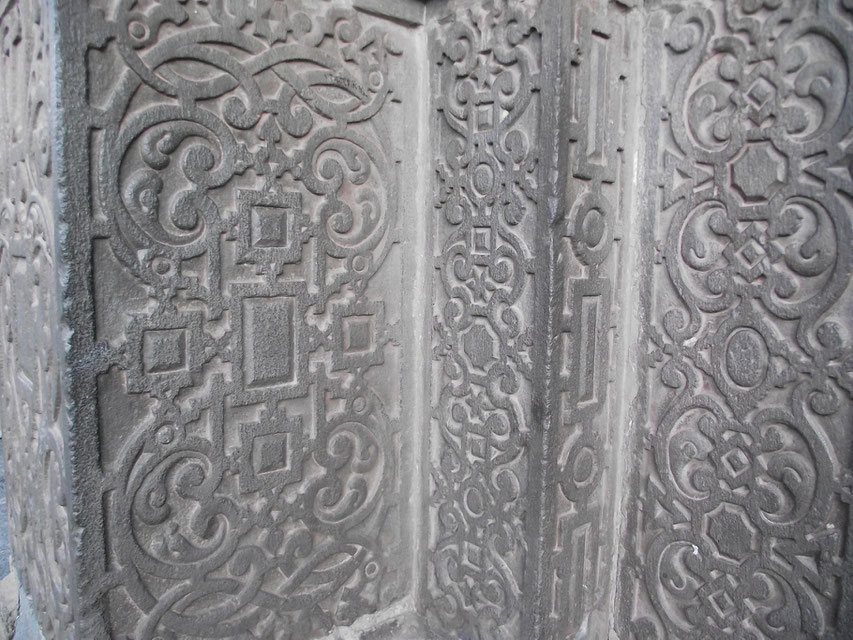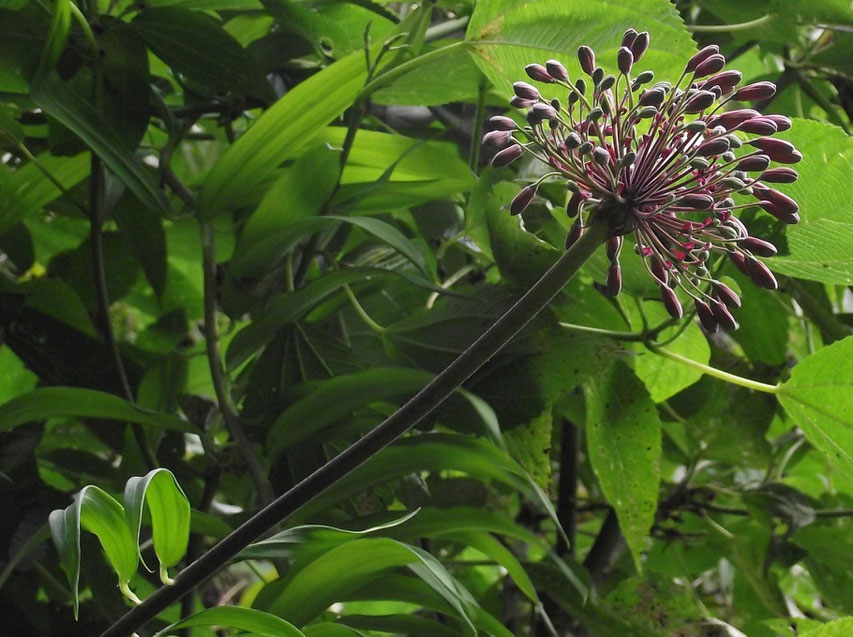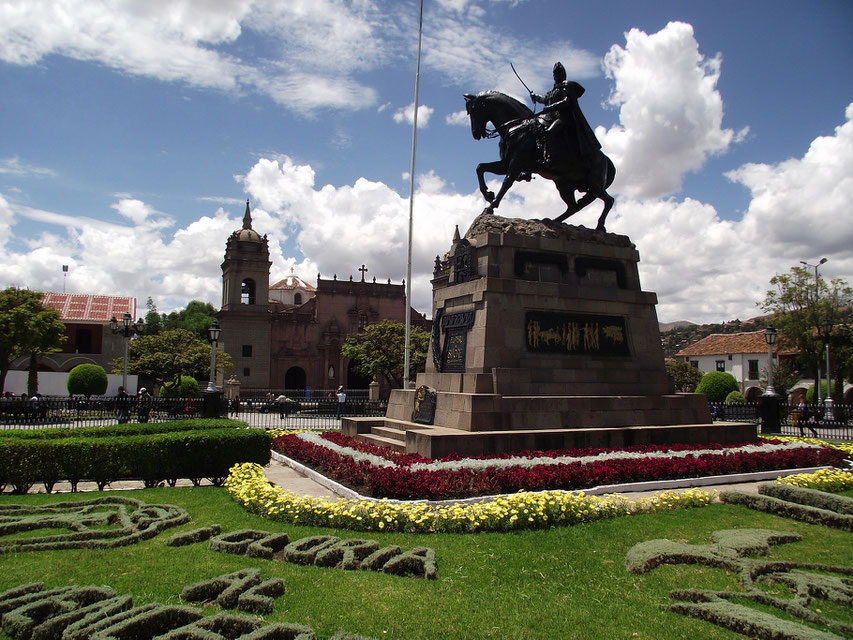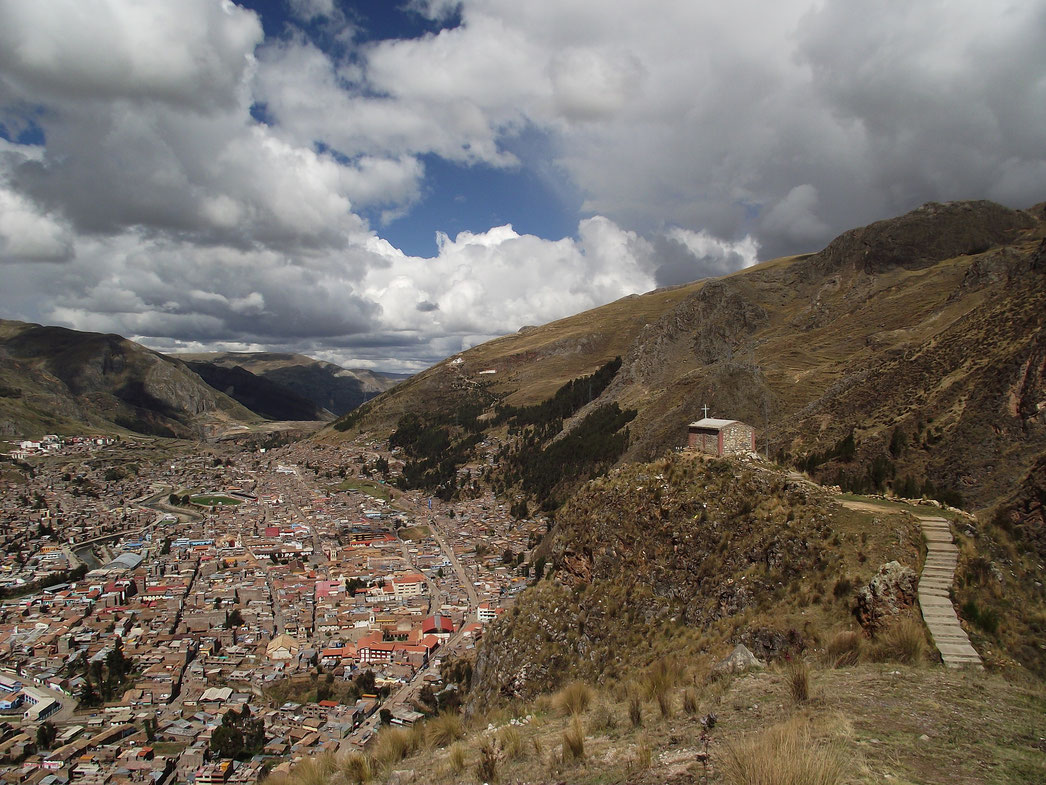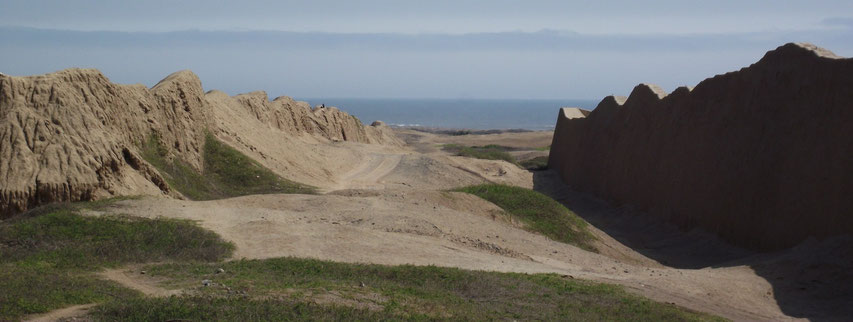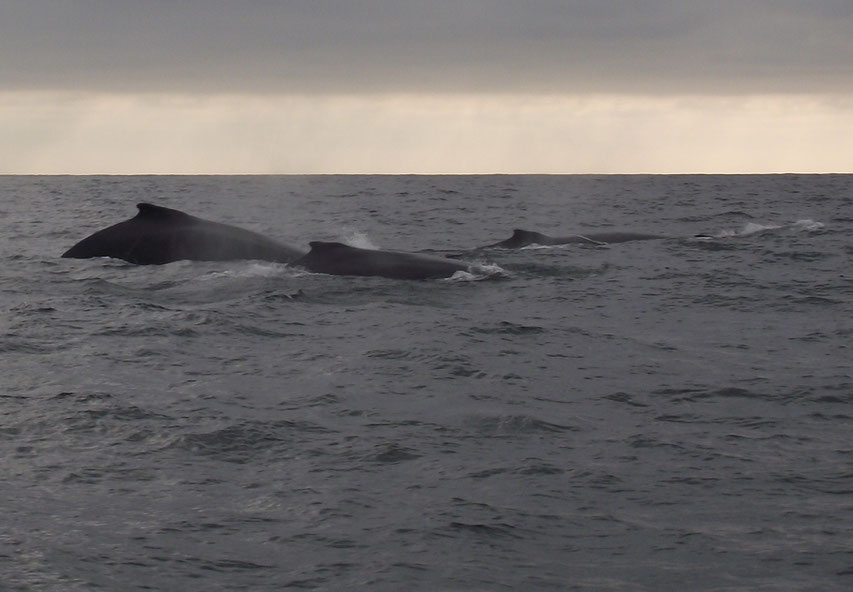'All over the place'

Here you will find a whole range of blog posts I might or might not be a little embarrassed about having written in my teens and early to mid-twenties. I had a range of cheap cameras, a naive style of writing, and bags of enthusiasm. There's a lot of hitchhiking, crowded buses, and volunteering in exchange for accommodation. They also aren't in date order...
Highlights include:
- An eight-month trip to South America where, excluding the flights [out and back], my now-husband Dan and I spent about £1000 each.
- European adventures in our [now sadly deceased] carpet van, Burt.
- Somewhat solo adventures in Morocco.
- Six weeks travelling along the banks of the River Gambia and up into Senegal.
- Hitchhiking from Sydney to Melbourne.
- Several months in South East Asia, a very, very long time ago...
Truly thorough scourers will find a series of tortured ramblings from my time working with
refugees in Calais.
Burnt trees and bumble bees - Spring between Gavião and Belver

I'm writing this in the present tense, because I can't sleep. Burt [the van] is broken, but we still don't know if this is the end of the road. Hopefully the mechanic will tell us in the morning and the wait, at least, will be over. On life's scale of problems, this is small fry, but I'm not very patient.
This is now our fourth night here in Gavião. I spent the first day moping in the room of our guesthouse; it was raining, but I still should have ventured outside. By yesterday I was already stir crazy: irritable and bored. The sun came out, so I walked out of the village, down the main road, round an empty roundabout, and out of sight. The roadside trees, plots of tall cabbage and distant barking dogs did me good. This place didn't know I was there. I floated loosely through reality like Schrödinger's cat, wondering if I might have disappeared.
Malhão - the big fishy beach clean.

After three weeks of storms and surf, I cruelly dragged Dan away from Sagres. We were going to head north.
Storms, Surf and the Plastic Tide - mostly around Vila do Bispo and Sagres
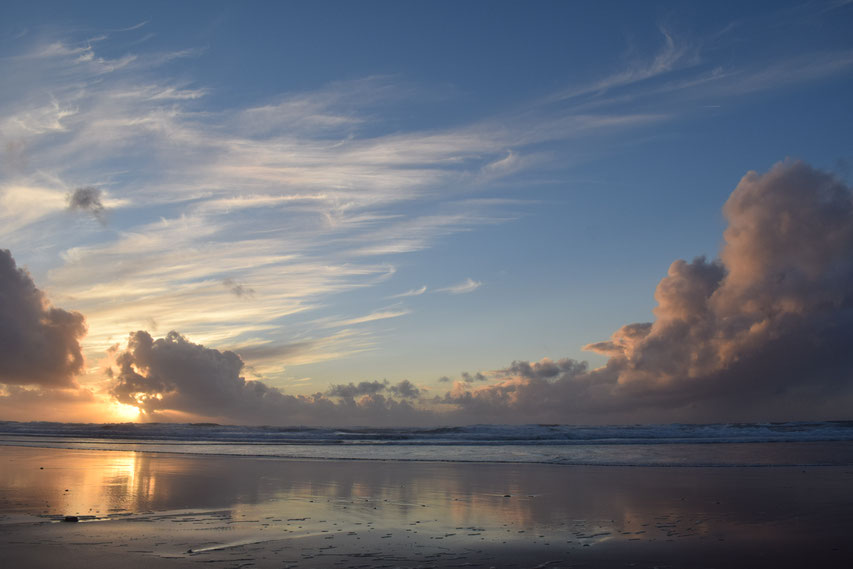
Finally free from the English winter, semi-permeated with grey but not entirely swallowed, I [we] fled south. Snow storms descended on northern Europe, clutching after Burt's* exhaust as he valiantly chugged through France; down past the ancient wood-striped houses south of Le Havre, missing a baby boar on the road and all the way to Basque country without even a drop of rain. In the small village Garmarthe, perched low on Pyrenean slopes, we bought cheese from the loft of a sheep barn; bread from bakeries and vegetables from green-grocers, we were determined not to just be a drain on the places we visited this time.
*Burt is the name of our van.
Serra do Geres (northmost Portugal), Galicia and all the way to Calais.

It's been several months since we lived in our van "Burt" and I still haven't finished the story. Though I can easily pick holes in places I was not that keen on or point out the most beautiful part of an otherwise average location, it rips at my heart strings to fail in describing a place I really loved. There is plenty of "average" in this final account, but my memories of Galicia are too special to be faithful to.
As a further avoidance tactic, I will begin by telling you about the North of Portugal and the van itself...
Burt was sick. He squealed and spluttered into life each morning, making a noise which sounded like a loose fan belt, but maybe not quite. As the wooring noise seemed to go silent after a couple of minutes, we ignored it for two days...
The Wind Turbines (high on too much time to think)
My notes say "near Afonsim? between Vila Pouca de Aguiar & Ribeira da Pena".
Walking towards the brow of the hill, I contemplated that although I like wind turbines, they seemed alien here. The last village we'd driven through had been half derelict, some newer buildings, but mostly old stone constructions, huge square bricks that reminded me of the Incas, but weren't quite as easily tessellated. People had stared at us as they often seem to, but it wasn't Burt, there were lots of old Hyundii H100s around Portugal. Sometimes they had open mouths or frowns, and we were starting to feel a bit self-conscious.
The blob rocks and the lucky swastika- Portugal
I'll quickly hop you through some of our more attractive one night stops before we get to one of Portugal's crowning jewels - the Serra de Estrela, some great archaeology and a magical spot by a frog filled river.
After Nazaré, we spent a final night with the waves beside the lighthouse at Praia Velha, São Pedro de Moel, before heading further north.
Surf and Turf (the more literal, vegetarian variety) -Southern Portugal
This is a bitty sort of story, partially filled with a combination of places I didn't really like that much and their best bits. I saw the biggest waves of my life, nearly fell to my death
off a Roman aqueduct and got eaten alive by mosquitoes. Enjoy...
After the best part of a week, the rain descended on Sagres and we fled up the coast. There are
many more dramatic cliffs and windswept beaches past Bordeira and further north, but we didn't venture out for more than five minutes at a time, my hair blown horizontal, until the sun came out
two days later. In the interim, we slept on the cliffs beside Monte Clérigo; I hadn't felt so buffeted since being in a storm under canvas and cooking was more or less impossible.
Six pristine beaches around Sagres, Portugal.
The main intention of this haphazard adventure was always to delve into Portugal, though I would have been surprised to find out that we'd enter from the South. Passing the most built up stretch of the Algarve in the rain, we bee-lined towards Sagres on the promise of surf.
March is a good time for waves, but attracts far less ordinary holiday makers. Though relatively quiet and very easy to park up our van at this time of year, I think you would have to be more careful in the Summer.
Countless vultures, a few waves and a very long tunnel (South/West Spain).
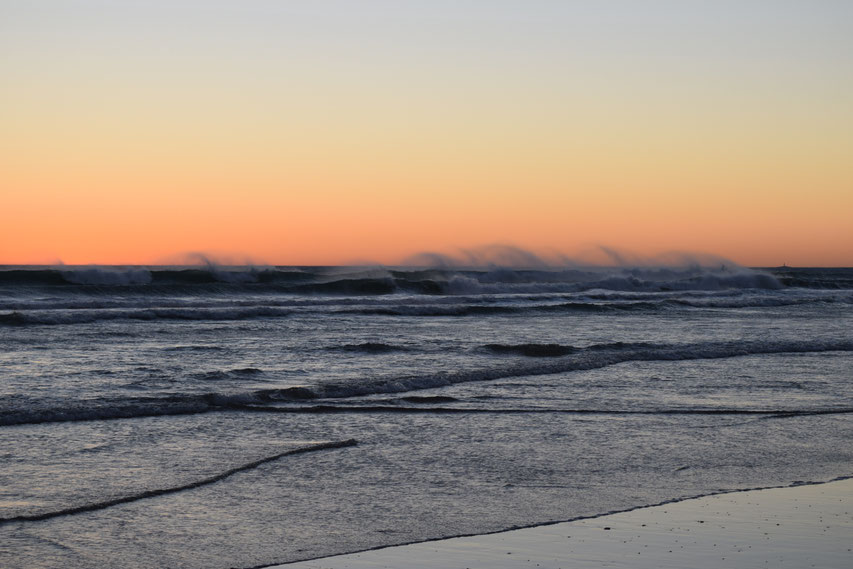
South from Ubrique, towards Alcalá de los Gazules, we drove an hour or so along small roads, though idyllic forested mountains, only persisting because every turn off was marked clearly as private land. For once our severely unspecific road map was correct in assuring us that there were no real settlements here, but under a mountain we found another "area recreativa". Somewhat of a labyrinth, "El Picacho" had barbecues cut into large boulders, picnic tables fashioned from giant hunks of wood and the generally overgrown delightful air of not having been visited much since last summer. The tree branches crooked above us like ancient witches fingers and we hid under the bridge, as the odd car passed above, like grubby trolls bathing in the river.
Several Spanish Sierras
By now we thought we were getting a little better at travelling in the van. We were driving in little hops, poking into the countryside or along the coast for an hour or two each day, never waiting until after sunset to find somewhere to sleep. Water was easy enough to find from taps in children's play parks, fontes or town centres, fuel was cheaper in Spain and we knew just about Spanish to make our lives a little easier. Slowly but surely our body clocks began to adapt from a slovenly 11am until after midnight norm, to one which made better use of the light. With little to do in the evenings, we were sleeping before the majority of eight-year-olds and I often woke up just before dawn started to scratch through the curtains. We appeared to have escaped the winter.
The river Ebro & its tributaries, the Spanish Civil War and alternative uses for shoelaces.
Had it not been for the gloom, I would have liked to stay beside Pantà de Rialb longer in the eerie silence, but we chased the promise of sunshine South. Skirting around Lleida, we followed a succession of steadily diminishing roads, looking for a blank spot on the map, as if paddling upstream to the source.
Pantà de Rialb and the lost villages.
The sky was stubbornly overcast as we approached the lake. Though with all the elements of beauty; reflections of leafy trees onto the green water's surface, rocky outcrops and a silencing distance from the highway, we couldn't shake the feeling that it was a little bit too quiet down this rough track. On the map, these roads lead to nowhere. I possibly expected a picnic site or somebodies house at the point where on paper it descended to the bank in two directions, but instead we got to a sign, "PELIGRO INUNDACIONES", and it simply became impassable in the van; great hollows and troughs down a steep slope.
On foot the road disintegrates into mud clots, completely disappearing and being replaced by shrubby bushes and rocks. What at first appeared to be a chimney poking out of a small clump of trees, turned out on closer inspection to be an empty shrine, simply a window to and from nowhere without the Mary doll to stand in it. We followed a faint and precarious pathway, still twenty-five meters above the water level, around a small headland and confusingly emerged onto the remains of a two direction tarmac road; only slightly faded white lines in the centre, but edges crumbling into emptiness. Over a sinking bridge, once proud enough for an archway, metal barriers meant to protect impossible traffic, bent towards the water like discarded staples. Sloped into a disturbing width ways diagonal, as well as the simple down-hill gradient, the road plunged into the water and obscurity.
France: a journey of three seasons and several lakes.
The morning of our intended departure from Morgins, Dan discovered that we (he) had left the head-lights on all night. Burt was in a coma. The oldest vehicle in the village by a good fifteen years you can imagine the spectacle we made heaving the van to the top of an icy hill and then charging down again with only the hand-brake to rely on. The slope out of the car park wasn't enough, but the only remaining gradient was right down through the middle of the village, road lined with kit laden skiers and troops of school trip children. A kind old man helped me get up some momentum and we watched as Dan hurtled a good hundred meters before bellowing out a puff of smoke. I hadn't been keen to be in the drivers seat...
Take two, step one - grazing through six countries.
If you've been dropping by for some time, you probably remember a little hype around last June. We'd saved and stagnated for over a year in Exeter. Unexpectedly, I'd found many things to love in that sleepy South-Western city; a small but solid medley of people, plenty of camping on Dartmoor and Devon's coast. Still, I was restless, we were gearing up for a great adventure. Burt the carpet van spluttered into our lives as a kind of tiny home on wheels, a fortified tent with space for a duvet, and we finally set of on our epic European road trip. Though the weather was better, things started that month the same as we just have, with a trip up to Scotland. As you might also know, that first drive up North and down was our last great road trip of 2016. We finished the year in Calais, laughing and crying and forgetting to shower. We're starting that original plan from scratch.
Trying to be a human after Calais.
In the end, we spent five months in Calais; stretching over nearly half of 2016, it went by in somewhere between a flash and a lifetime. Days were over before they'd begun, but the weeks dragged out endlessly. Now that we're out, it feels like waking from a bizarre hallucination.

The Jungle is finished, but we haven't quite...

For months the "Jungle" was our entire existence; warehouse, jungle, warehouse, jungle, lidl, warehouse, junglejunglejungle...
We lived and breathed it until there was little left of our previous selves, but then they were taken away. We have no idea what has happened to the vast majority of the people we saw every day.
Exhausted and lacking direction, most of us left. It seemed like our work was done, but Dan and I faffed, tying up "loose ends" and fitting
new brake disks to our long immobile van. After the children were finally gone, I languished around the yard for the best part of a week, occasionally attempting a little clothes sorting or answering the questions of new volunteers with dead eyes and monotone half sentences.
What were we doing?
The fate of the "Jungle" Bambinos.
I'd gone from taking clothing and shoes to almost exclusively adult men and older teenagers, to spending all of my time trying to care for children. Frankly I had no idea what I was doing and neither did 90% of us. We tried to occupy them with football and games in a field next door, but spent most of the day and evening listening to their problems and trying to make sure they have working phones before they disappeared. They were growing boys and hungry however much we try to feed them, there was no running water inside the containers and many told me that they washed their faces in the water from the toilets. Helplessly I worried for their teeth.
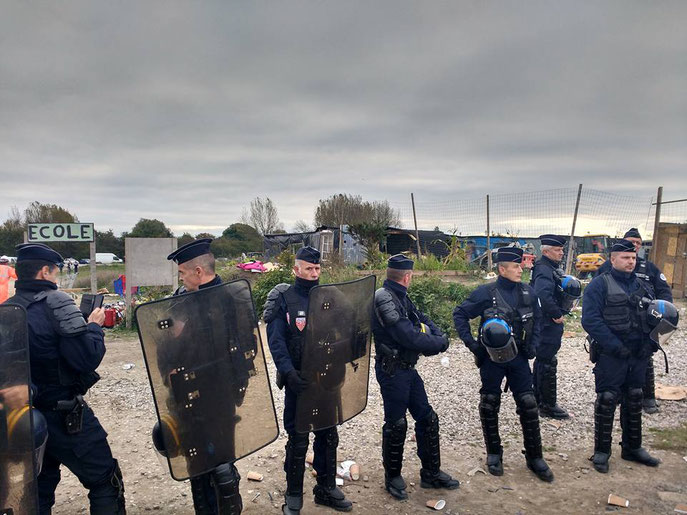
Disconnected stabs of consciousness from Calais.
I've written very little about Calais over the last three months I've been here. There is so much to say and yet none of it forms in my head into a coherent narrative, message or anything even close to a solution. The jungle is finished, but I still feel like I have so much to learn. I never took any photos, I never said my goodbyes, all lost threads from a tapestry of unsolved problems.
Jungle halas.
The impossible task we've been attempting is drawing to a close and I feel both absolved of responsibility and drowned in sorrow about the people we've had to leave behind. I'm not allowed in anymore and am suddenly redundant. Strings of half made thoughts race around my brain; jobs I never got around to, referrals lost in the depths of my phone.

Uncertainty in Calais...
Time melts on as if it has no meaning. The rumours are rife- "Jungle finish?" we're asked each day. Nobody wants it to be here but they (and we) are constantly anxious about what that means. Nobody wants another eviction, we can't loose any more children in the process, but there's no way we can sustain over 10,000 people over the Winter without being allowed to build more solid homes. We live day by day, maintaining their existence, providing clothes, food and some sort of shelter, but it's not getting better. In over two months, I've taken a few days to myself, but there are others who've been at it since Christmas.

Some time on Islay, Scotland and the carpet van makes it to France.

After a very slow and somewhat arduous trip up to Swansea, Wales the week before, we were particularly relieved to make it up to Scotland in relatively good time without any major mishaps.
In between fixing rusty holes in the van, changing our oil (and spilling a whole tank full onto my parents’ drive) and generally trying to sort ourselves out a bit better before leaving the UK, we found a little time for the beach...
"Building" in the new Dunkirk refugee camp, France.
After two weeks of stumbling through our daily reality, Dan and I were struggling to find any purpose. Stretching the Easter bank holiday weekend, we found lifts over to Calais and were quickly back in the build team. With its regimented streets of chicken coops, Dunkirk couldn't be any more different to "the jungle". Having never seen the old camp, I can only repeat other volunteers' stories of children trying to play in a wood turned swamp. No building materials or tents had been allowed in for months and Winter conditions must have been nearly impossible before the move.
Overshadowed by the jungle, Dunkirk was just one of many forgotten refugee camps in Europe. I'm struggling not to get too political, but the new camp, set up by MSF and volunteers, at least gives a small amount of dignity back to the thousand and a half people it has space to shelter. There are toilet facilities, showers, somewhere to wash clothes and food distributions from the other charities involved. It hasn't solved their long term problems, but hopefully eased a bit of suffering in the mean time.
Volunteering for l'Auberge des Migrants in the Calais "Jungle"
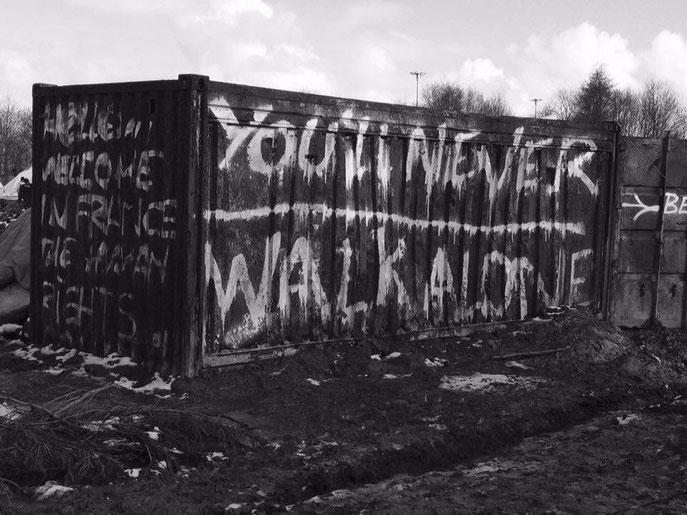
*If you haven't got time or energy to read my waffle and are simply interested in the logistics of
volunteering, slide right down to the bottom and read the useful information section.*
**These photos are borrowed from the friends I met in Calais. Thank-you in advance.**
I'm struggling to find the tone of this article; shying away from self-congratulatory or callous, and after only a week there acutely aware of my naivety. On leaving, nearly everything in my normal life seems pointless and yet I still bumble along as if before.
I've been wanting to help the people stuck at Calais since early last year, but excuses tumbled over each-other and it wasn't until last week that we finally sorted ourselves out enough to spend a little time around "the jungle"*.
*The name made me uncomfortable before we went out, but since meeting a few of the refugees, I begin to think of it as a dark in-joke between those who've been forced to live in a situation that many of us wouldn't wish on our pets.
The Gambia - an Introductory Guide.

I first wrote a version of this post for Anita Hendrieka, but I put a lot of thought and effort into it, so I wanted to share it with you here too.
Over the past decade, I'd spent plenty of time exploring Europe and South America, some in South East Asia and even Oceania, but was ashamed to have never ventured further into Africa than Morocco. I didn't have any idea what to expect from The Gambia although, having studied History, I had no illusions as to why this tiny river-bank country in West Africa spoke English.
Our colonial past and resulting wealth is uncomfortable and unavoidable, but I felt very little of the resentment I expected. Life has been, and continues to be, very hard for the majority of Gambians. Wages are extremely low and there is a lack of opportunities for young people which increases the further east you travel. Despite this, Dan and I were usually treated with warmth and respect, never felt at risk of a crime (a notable difference from certain parts of South America) and was guided through the country like a baton in a never ending relay race of people offering to help. Travelling east, “up-country”, where the taxis turned to donkey carts and people were still surprised to see us was easier than we'd imagined and I believe that we would have had a very different experience had we spent our time in cities and tourist beach resorts.
It is a country of violent seas, fishermen and complicated mangrove networks. The variety of birds is world renowned and my only naive resolution (to see a baobab tree) was completed countless times within the first week, but (for me) The Gambia was about Gambians.
Why are phones so important to refugees? - introducing "Phone Credit for Refugees & Displaced People"

It's nearly two years since I left Calais. The refugee crisis is less of a deafening scream, swallowing my other thoughts. Now it is more of a solid lump, a quietly judgemental resident
in the side of my mind; we are cohabiting the space and doing a somewhat reasonable job of getting on with another sort of life.
This isn't about my head though; this is about the group "Phone
Credit for Refugees and Displaced People". Observant readers will have noticed their link at the bottom of my site and anyone who follows me on social media was probably bored of
hearing about them years ago.
"You don't even have a smart phone Katie! You haven't checked your voicemail for three years! Why do you care so much about refugees having phone credit?!" I hear you protest.
Let me tell you why it is so important for refugees to have phone credit...
Behind the Scenery — Plastic Pollution and Some Small Ways to Help.

Painfully brought to the public's attention by the genius series Blue Planet II, plastic pollution has been a hot topic this year. As bloggers, photographers and general Planet Earth enthusiasts, it's easy to present the places we love as we wish they were; to crop out the ugly parts or direct our cameras elsewhere. This collaboration is an attempt to rectify the rose-tinted vision we have often portrayed. Nowhere is left unaffected by the plastic plague.
Popenguine - Peace and Quiet on the Petite Côte, Senegal.
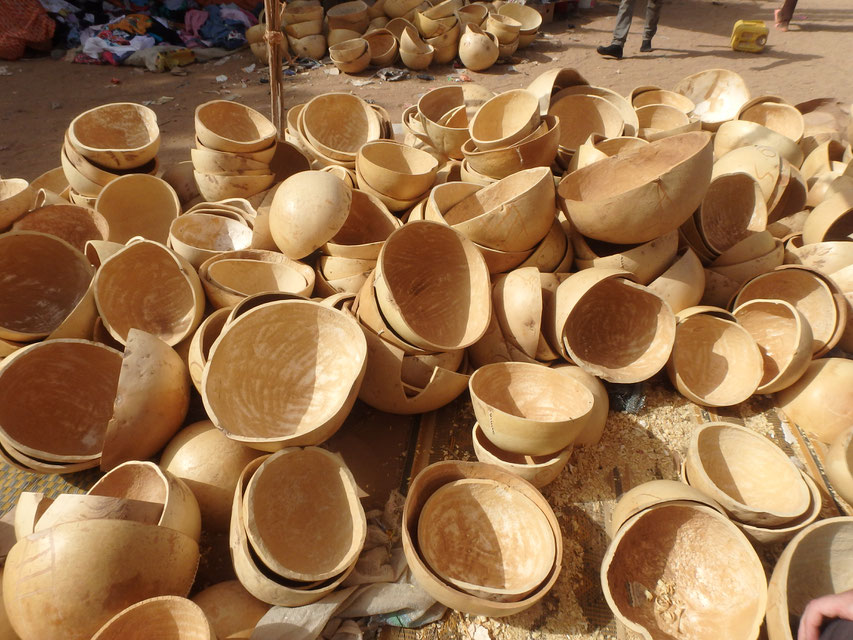
We arrived at Popenguine at the end of the Pentecost festivities. The streets were a mess of half-deconstructed market stalls, stumbling revellers and strewn plastic cups. Feeling tired from the
journey, we were thankful to find that – apart from pointing us in the direction of the ancient church – nobody paid us much attention. There were a few other toubabs*, enough to make us
unremarkable, but they mostly seemed to live there and (in May) there was little tourism to speak of.
*White or foreign people.
Backpacking The Gambia and Senegal - a Complete Packing and Pre-Departure Check List.

My partner Dan and I were backpacking around The Gambia and Senegal for six weeks. This is the information I was looking for before we left...
Unless (like us) you are carting around bodyboards or other specialised equipment, there is no reason why you can't fit all your luggage into a "day pack", hand-luggage sized bag. The warm
weather means you can usually wash and dry things within a few hours, but if you do find you need more clothes, a visit to a fabric shop and tailor is fun and affordable (between three and ten
pounds for a shirt in The Gambia) and second hand clothes markets are common. Almost anything broken can be fixed, so make sure you ask around before throwing stuff away.
"Un Peu" de la Petite Côte and Plenty of Pelicans at Mar Lodj, Senegal.
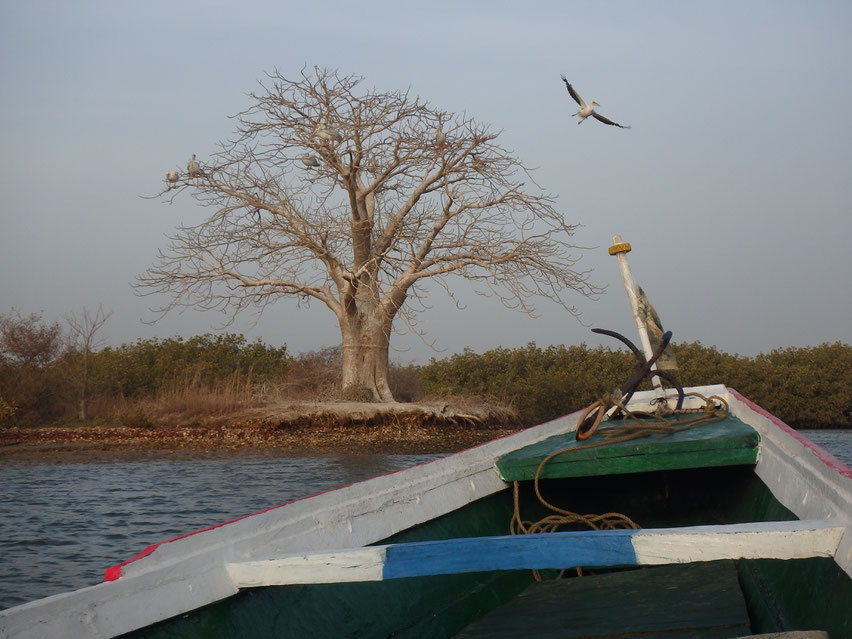
After crossing the border into Senegal, we made a bee-line for the coast. We were looking for surf in Toubab Dialaw; it took three days to arrive. We walked south, right out of the village, to where women were collecting rocks from the sea and then a little further, and bobbed in the waves like seals. When it got bigger, the ride was short and dumpy, smashing Dan into the sand and grazing his head. It didn't stop him trying again of course.
Practical Information - Gambia/Senegal Border Crossing (Amdallai/Karang)
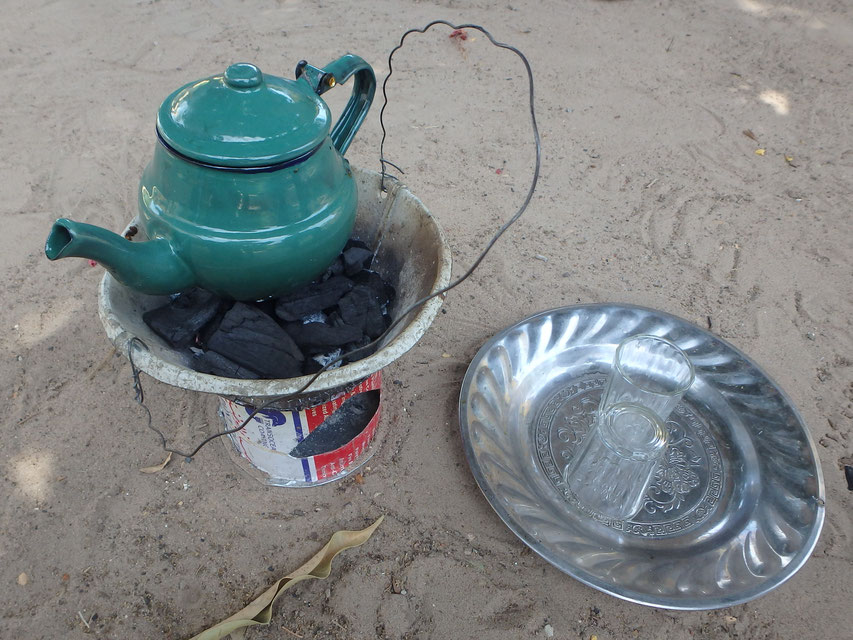
This is a very boring post, please proceed directly to either of the following unless you need advice:
- Slowly, slowly up the river Gambia - from Sanyang to Bwiam.
- From Bwiam to Basse, but mostly around Janjanbureh, then back west along the North Bank.
If you are looking for pre-departure packing and preparation tips for backpacking in The Gambia and Senegal, I've written a whole post for you!
From Bwiam to Basse, but mostly around Janjanbureh, then back west along the North Bank - The Gambia
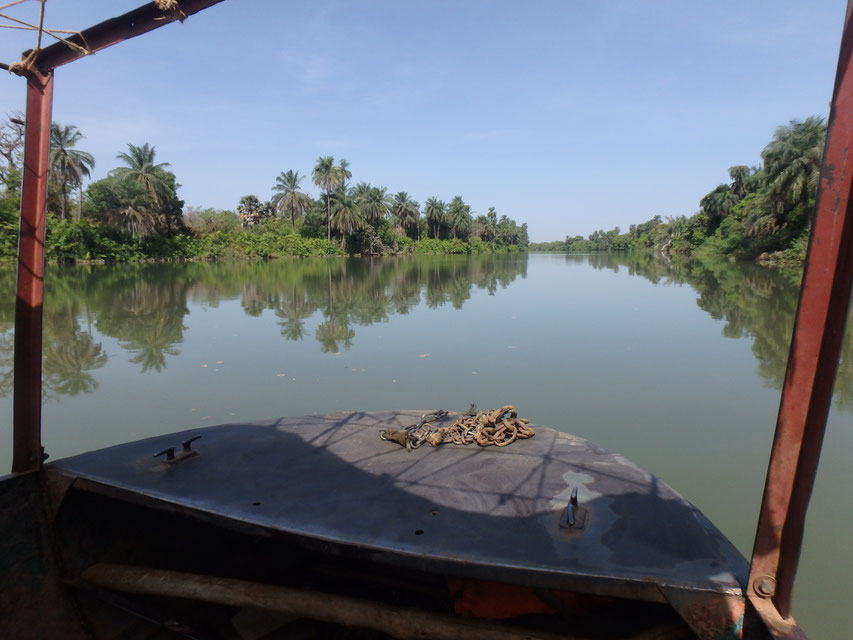
Travel onward from Bwiam was hot and mildly confusing. Initially we caught a big bus to Soma. Out of the window, what limited modernity we had become accustomed to dropped away; roofs changed to thatch and houses shrunk, men began to wear robes more commonly than t-shirts and horse carts soon outnumbered private vehicles. Soma was predominantly a busy intersection, swirling with dust and criss-crossed by semi-panicked donkeys. We went to check the bank for an ATM and were greeted by a nervous, armed security guard, his finger on the trigger, who seemed eager for us to leave. It was much more confusing than threatening. We quickly found a gelly-gelly bound for Janjanbureh.
At any given time, it is rare to be further than thirty centimetres away from a baby on public transport. We provided in-transit entertainment or sometimes accidental terror. Up until that day we had found travel to be quite fun, but the novelty wore off as we waited for the minibus to fill up; trundled off after a bump start (nearly leaving Dan behind); and proceeded to stop what felt like one hundred times, once for as long as an hour, over as many kilometres. To the other passengers dismay (and our confusion) merely a tenth of the journey away from Janjanbureh, we were turfed out of that bus and onto another. Then we waited for that one to fill up. All in all, one hundred and eighty kilometers from Bwiam to Janjanbureh took us seven and a half hours. Dan was getting an increasingly bad back and upon arrival, we accidentally paid one hundred dalasi instead of ten for the five minute ferry crossing across the river Gambia. Finally, we arrived on the north bank dispirited, dirty and on the verge of heat stroke.
Slowly, slowly up the river Gambia - from Sanyang to Bwiam.
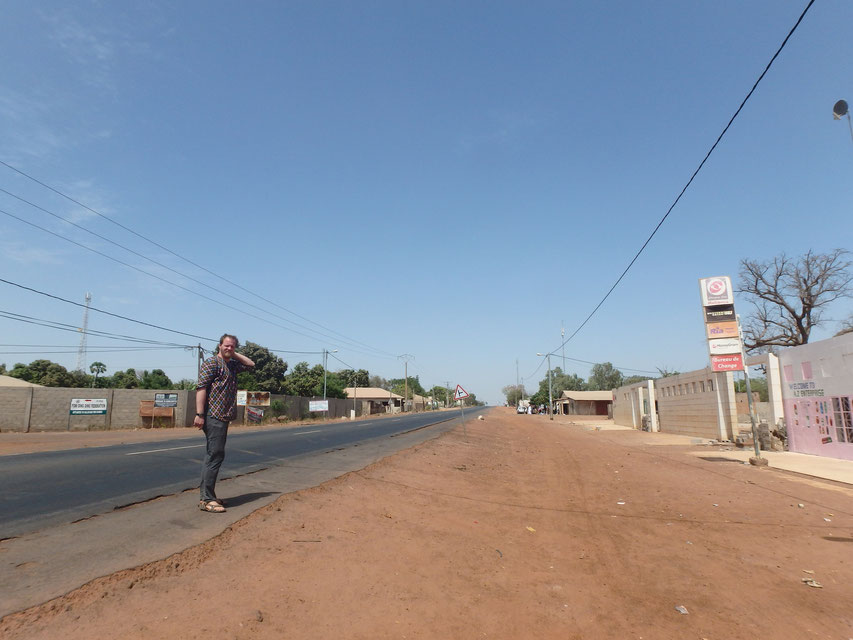
We lingered in Sanyang, nervous of our next step, hiding amongst other tourists we didn't even like to avoid the unknown quantity that was public transport. There is limited information about this sort of travel within The Gambia; no such thing as bus times, numbered stands or labelled destinations. What hints I could find were so vague that I could have assumed them. Unable to delay any further*, we set out early one morning to walk the few dusty kilometres into Sanyang town.
Tumani Tenda - The Gambia
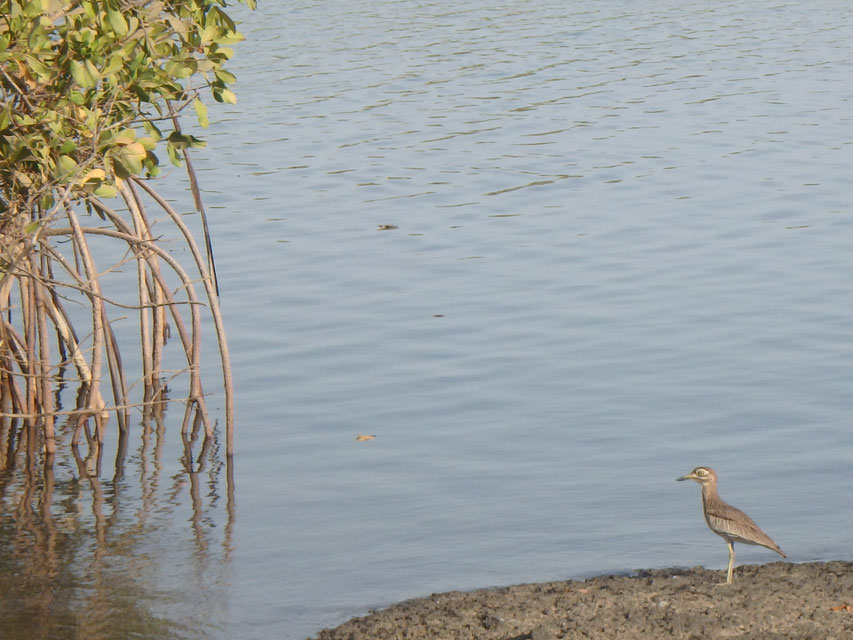
Staying there for nearly a week in the end, I have struggled to put my experience of Tumani Tenda into a digestible format. As is so often the case, the atmosphere was made by the wonderful staff, so I am trying to do them justice.
For learning about life in a Gambian village, about sustainable farming or for bird watching, it's hard to imagine a more ideal set up. The prices are listed upon arrival, so there is no need to haggle and activities are very affordable coming from Europe. Most importantly, any profit made is channelled straight back into the community.
The following information is enough for the basis of a thesis, so I have broken it up into sections. You might just want to look at the photos...
Rainbow Beach Bar and Lodgings, Sanyang - The Gambia

Far from fresh-faced having slept in the airport, but new to The Gambia, we were not looking for a challenge in our first few nights in the country. Avoiding Senegambia, the most popular and notoriously tourist infested strip of beach further north, we found Rainbow Beach Bar and Lodgings by the reliable method of arranging accommodation on booking.com* in order of lowest price first...
*Not an advert!
Photographer Jason Wallien - living and working in Beijing.
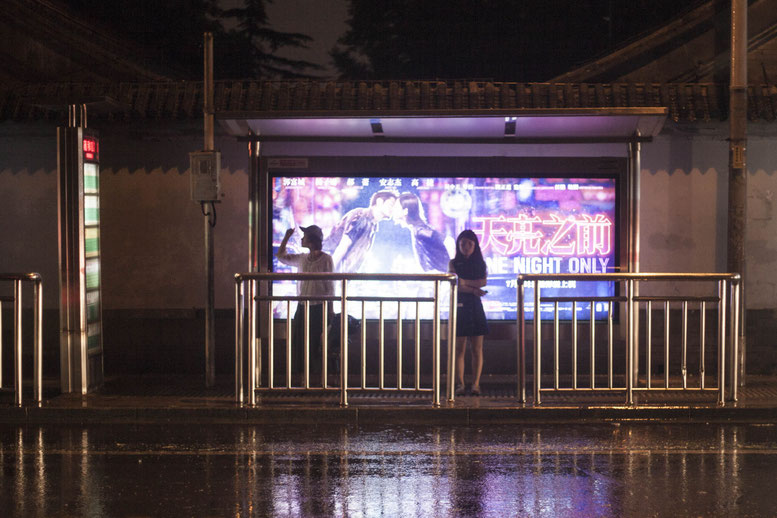
Jason has been living in China for almost as long as I've known him. I don't think he intended to be there for so long, but something about Beijing has obviously reeled him in. I first asked him if he would do an interview for me, about his life there and photography, on the 3rd of January 2015; between the two of us, we have managed to string it out until now... I think it was worth the wait. I particularly love his photos of lights and rain in the darkness and for me, his answers are a rare insight into a idea I once considered for myself. We cannot be everywhere and do everything in the same lifetime, so it's good when our friends can be some places for us. I hope you enjoy the read.
Why and how we should be trying to preserve our Oceans.

Having spent quite some time ranting about the refugee crisis, I wanted to write about something else close to my heart, incredibly
important, but not yet personal enough to make me shake with rage.
Covering almost three-quarters of the Earth, holding 97% of our water, producing almost half of our oxygen and absorbing carbon from the atmosphere, I can't exactly overstate how important oceans
are to our planet's survival. Despite being vital to our economies and way of life, gone are the days when it was possible to believe the deep blue sea was simultaneously an infinite wealth
of resources and an invulnerable dumping ground.
Storms, sea shells and sand boarding in Mui Ne, Vietnam.
After over a year's waiting and saving, I'm soon setting off on another adventure. I couldn't be much further from travel burn out right now, but somehow this sprung to mind...
Trying to loop through the North of Thailand, floating along a portion of the Mekong, through Laos and down the entire length of skinny Vietnam in just a few weeks, had turned into somewhat of an ordeal. Vietnam is a beautiful country, with some of the most impressive sights in South East Asia, but after spending around one hundred hours trying to sleep on hard train benches, sweating on endless busses, occasionally getting shoved and ordered around by unfriendly men and fighting off moto drivers, the continuous traffic noise and incessant beeping was beginning to grate.
Tips for women planning an adventure in Morocco.
Drunkenly booking myself a one-way ticket to Marrakesh, age 20, was undoubtedly one of the most impulsive decisions I've ever made. I had some idea of what Morocco might be like, but the more I researched solo-female travel there, the more I began to wonder if I had made a giant mistake. As the weeks before my departure flew by, I got increasingly nervous and tried to arm myself with as much information as possible.
In hindsight I had no reason to worry, but these are the tips I wish I'd read before I left...
Camping spots that make you wonder why we ever sleep indoors.
This collaboration of magical camping spots has taken an embarrassingly long time to put together, but I can't help but feel proud of the result. With some of my traveller idols, friends and even family involved, it's hard to decide if I'm more excited by the contributors or the places they have written about. If this doesn't persuade you that you don't always want to sleep with a roof over your head, then I'm happy to keep the wilderness for myself.
Finding our green fingers in Langkawi, Malaysia.
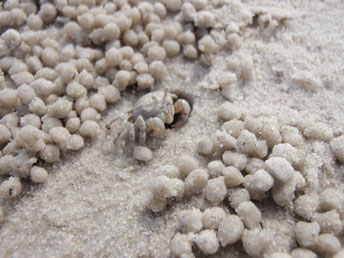
Langkawi is actually a string of over a hundred islands not too far off the North-West coast of Malaysia. We only visited the largest of them, Langkawi itself, but with long, sandy beaches,
jungle coated mountains and a rich variety of wildlife, it had everything I'd hoped for in a tropical paradise without the fringing of lobster sunbathers.
Although the coastline is stunning, we spent the majority of our time exploring the island's green interior.
Backpacker highlights of Australia's East Coast...
English speaking, easy to get around and lined with long, sandy beaches, Australia's East Coast is perfect for inexperienced travellers. The distances should never be underestimated, but buses are simple and for the slightly more confident, it's perfectly possible to hitchhike. Big hostels often attract a young, party crowd though older travellers can always find smaller, independent accommodation or even better camp.
This post will focus on some of the East Coast's islands and backpacker highlights that I loved on my first trip to that side of the world. If you're trying to plan a gap year, this should be perfect for you. Hopefully, more experienced travellers will also appreciate the stunning coastal scenery, brilliant snorkelling opportunities and unique wildlife.
Bumbling through central Bolivia- crazy cities and very many monkeys.
I've been putting off writing this for months...
My last post from Bolivia? The last post from South America and the eight month adventure that Dan and I drew out for as long as physically possible. We had to fly back at the beginning of this year- it's already April, but I still can't quite get over it!
Anyway... the post is entitled "bumbling" as by this stage in the journey we had extremely dwindling funds and really no idea what we were going to do for another two months. Not everywhere we went I could recommend, but I'll share all the information in case you find yourself in a similar situation. Otherwise just sit back and enjoy the monkeys.
Dangers, disasters and dodgy situations in Peru and how to avoid them.
Peru is an incredible country with culture and wildlife as varied as the landscape. A mountainous spine teeming with archaeological sites and home to many proud indigenous communities divides the land between the desert like coast line and the Amazon.
With the fastest growing level of tourism in South America, increasing a whopping 25% annually* and now taking its place as Peru's third largest industry, you could be forgiven for thinking there is safety in numbers. Maccu Pichu is top of many backpackers “bucket-lists” and the country as a whole has been a firm favourite on the trail for several decades. With all this in mind, I was surprised to hear of more traveller disasters in Peru than I did in either Colombia or the capital of Trinidad and Tobago.
Why was that and how can you avoid the potential problems?
El Jardin eco-campsite and accommodation, Samaipata, Bolivia.
Having spent a week or so hopping from one nasty, [relatively] expensive accommodation to another, we were heading to Samaipata in the hopes of finding a peaceful campsite. Being enormously ripped off on a long, hot day of buses, I was feeling quite miserable by the time we arrived. It was dark, raining, everything was soggy and I wasn't appreciating being stuck back in our one-man tent. Balancing electronics and valuables on a mountain of shoes, under waterproof coats in our 'porch' to stop the water from destroying them didn't lead to the most restful night's sleep.
Waking up groggy with sun, I found El Jardin more intriguing than I could have imagined...
Falling down the rabbit hole- life in the woods at Espiral de Luz, Samaipata, Bolivia.
I've been struggling over this post for week - how to explain my two month hiatus, how to cobble my words and photographs into describing my total infatuation with this little patch of woodland. It's been twenty-six days since we were forced to leave, but I still wake up expecting to hear the sound of insects, before realising the sad truth and missing the beautiful simplicity of that life. I'm finding it hard to move on, to step forward into modernity and realise I don't like the way the world is going, but lets start at the beginning.
Coiroco- tropical garden of the Yungas, Bolivia.
The Yungas, where the rain-forest begins to creep into Bolivia's towering mountain range, are just a few hours North of La Paz, but an entirely different world when you actually arrive. With panoramic views of tree coated mountains from the picturesque town centre, Coiroco seemed like a promising beginning for an adventure.
Lake Titicaca: Copacabana and the Isla del Sol.

Please note: this post was written in 2014, so the situation is likely to have changed.
Entering Bolivia at Copacabana, it's hard to remember this is a landlocked country. Wide enough that the horizon is flat in places, with sandy beaches and the occasional seagull, Lake Titicaca is a beautiful concession for the Bolivian's stolen coastline.
The high road: Ayacucho to Cusco
For useful strictly travel information see the bottom of this post. Information was correct in 2014 and hopefully hasn't changed too much!
I'm finding it hard to decide whether I love or hate the pompous postcard material photo above, but it gives you a good idea of the grandeur of this city. Ayacucho, a name I´d never heard a couple of weeks before arriving, feels a world apart from other cities we've visited in Peru. Unlike the crumbling concrete structures of other metropolises, here we found well maintained colonial structures, wide, clean streets and an air of independence. With an interesting but troubled history, only connected by a paved road to the outside world in 1999, Ayacucho has developed differently to elsewhere.
The high road: Huancayo, the train and Huancavelica.

After arriving in the North of Huancayo (a city of over 300,000 people), trekking to the East only to find an enormously overpriced campsite and then finally walking all the way down to the South with our bags, in the dark with rain lashing down on us and thunder in the background, we were exhausted and predisposed to dislike the city. Luckily a fantastic Chifa (Peruvian Chinese food), meeting up with our friends Coraline and Greg and exploring the never-ending market improved our experience greatly.
This market, possibly the biggest I've seen in South America, was a great place to buy anything from reasonably priced knitted handicrafts and delicious snacks, to a new lead for Dan's camera. It took us the best part of a day to explore.
The friendly city of Chiclayo.
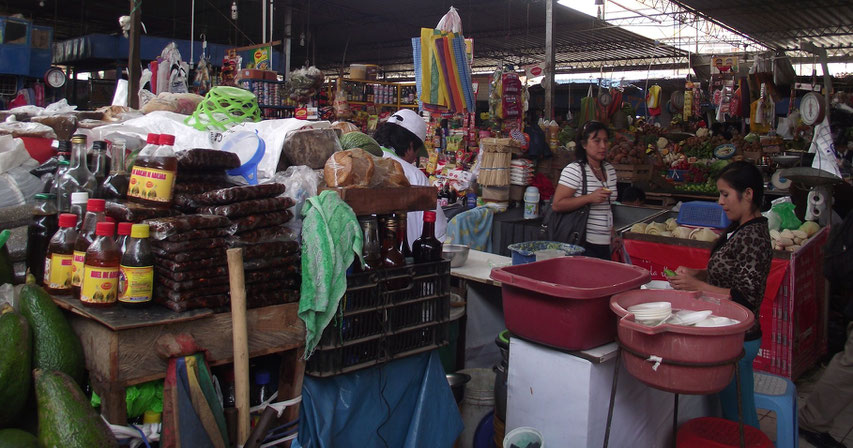
Chiclayo wasn't the sort of place I'd really expected to like: with quarter of a million people, backstreets smelling strongly of urine and a constant sound of beeping taxi horns, it was not at first glance a very appealing city. Actually the fact we ended up staying there at all was mostly a misunderstanding with the buses, so my expectations were low.
Hospedaje San Lucas has such a tiny entrance that we walked past a couple of times thinking it must have shut down before spotting the faint blue 'backpackers' on a yellow door frame. However, after being greeted by a remarkably friendly lady and discovering we had our own room with bathroom for S40 (about £4 each), we decided to stay a while to see what Chiclayo had to discover.
Cabo Blanco- a safe haven in Peru.
By the time we left Mancora, our first stop in Peru, Dan and I were feeling pretty down. Although nothing terrible had happened, we'd spent too much time in tourist hell-holes, been ripped off a bit too often and just felt a little out of our Spanish speaking depth in the dirt-cheap campsites we'd been staying in. To make matters worse, a manic, middle-aged Australian woman approached us in Guayaquil bus station asking for $10, quickly changed her story and ran off with the money without saying thank-you. The final straw came when, after only managing to hitchhike about 50km all day, our final lift turned out to be an "unmarked taxi".
We were on the edge of the mountainous desert- the out of sight coastline on our right and the desolate town El Alto on our left. Both directions seemed like a long hot walk, so when a truck stopped to ask us if we wanted a lift down the cliff road we jumped straight in the back.
Safety warning: Huanchaco taxi robbery, Peru.
A French couple, friends of ours, left the campsite at 8.30pm to catch a night bus from the nearest town Trujillo. Three or four hours later they returned with bruises on the man's face and having lost almost everything they owned. The story unfolded like this...
Whale watching, fishy street-art and hitchhiking Puerto-Lopez to Ayangue.
Bouncing along in the back of a fish-truck we watched the parched, cactus territory along the coastline turn to lush forest. With isolated micro-climates changing the scenery from place to place, Ecuador is amazingly varied for its size. Winter is warmer than Summer here, but the only season I didn't want to miss was when Humpback Whales come to mate. We'd spotted a few from the beach at Puerto Cayo, but it's hard to get a sense of scale at distance and I really wanted to see them up close.
Fishing boats of Manabi province, Ecuador.
The coastline of Ecuador's Manabi province is dotted with fishing villages. Each boat is carefully decorated in the style of it's owner and the fishermen are understandably proud to show them off.
Wandering along the beach at Canoa
At weekends, the stretch of beach directly in front of Canoa's town centre is mayhem. There are hippies selling jewellery, places to buy fresh fried octopus and the usual pot-bellied middle-aged men lying prostrate on the sand. Occasionally you might even see clueless tourists bobbing along on horses which will only move if chased by a man running behind with a whip. You'd be lucky to find a couple of square meters to lay out your towel and turn your head away for a second too long, your bag might disappear.*
Mindo: hummingbirds and butterflies, but not really a waterfall.
Camping next to the river, surrounded by cloud forest, with the occasional eagle swooping overhead, we've spent most of our time in Mindo cooking.

A final few days of celebration and a sad farewell to La Esperanza.
There have been few places in the world that have brought tears to my eyes when it came to time to leave. As I'm sure I've made quite obvious in my last four(?!) posts about La Esperanza, Dan and I really loved living there. This post isn't going to be very informative, but mostly a thank-you to the friends who made us feel so welcome in the village.
We finished painting the house just in time for fiesta of San Juan. This was the third fiesta we'd been part of in La Esperanza and by far the most extravagant. There were lavishly decorated vehicles throwing out sweets and roses for spectators and several parties of costumed dancers; everyone was wearing their finery and some people even brought their animals along to display.

Casa Aida- A Home Away From Home.
Usually when I see signs outside a hostel stating it to be my 'Home Away From Home' or similar cliques, the sceptical voice in my head replies with something sarcastic.
Thankfully this time I was proved entirely wrong!

The third house we've painted this year...
As you might have seen in my previous post about the history of Casa Aida, the hostel was beginning to look a little run down...

Why are we still in La Esperanza? -Northern Ecuador
I think it must be well over two weeks since we bumbled into La Esperanza- I've lost track and Dan has no idea. For anyone travelling between Ecuador and Colombia, this is a perfect spot to relax before or after dealing with the border crossing. Probably the best way to explain this tiny, slightly dilapidated town's hold on us is to show you it's setting...
Casa Aida- a story to restore your faith in life.
Our home for now is a tent in the garden of Casa Aida, a lovely hostel in the tiny village of La Esparanza, Northen Ecuador. This afternoon we were lucky enough to hear the story of where it came from- it's probably the most beautiful I've ever heard...
In the early seventies, with no money after a messy divorce, Aida was searching for somewhere to live with her three children. She came from Quito to look at house here in La Espranza, but was disappointed to find that for 75,000 sols it was barely habitable. In a very bad condition, filled with rubble and weeds, with a tiny dirty kitchen and no bathroom, it was hardly a house at all. She went away disheartened, but after struggling for another couple of months in the capital was persuaded by some friends to come back for another look. 75,000 sols was the equivalent of $3 (current US money), but a lot to save in Ecuador at the time and not an amount she owned, but nobody else had come to look at the property in the mean time and the owner was desperate to sell. Eventually they agreed upon a trade- Aida exchanged a record player, some cutlery and furniture for the house!
The children weren't impressed, but with no money to rent it was their only option. Aida did her best to clean up the house, getting rid of the rodents and rubble, but couldn't find a job in La Esperanza. Out of desperation, she started to travel to Ibarra* each night to sell burgers. For a pathetic 100 sols a night, she was having to leave her children locked alone in a room and hide her face from the other night-time lurkers ("the homeless, thieves and ladies of prostitution") in the bus station each night. With no time for sleep herself, getting the children up for school and trying to make the house habitable in the day it wasn't sustainable. Eventually she found work ironing and embroidering shirts here in La Esparaza, but was still having to work from 6pm until morning to iron enough shirts to feed her children. Life was desperate and Aida grew pale and thin from the stress and fatigue.
One night she heard talking outside in a foreign language- it wasn't Spanish, English or the local language here, but turned out to be a group of twelve Italian hippies. They had come in search of the magic mushrooms which use to grow here and asked if they could pitch their tent on her land as they looked so poor and dirty that no hotel in Ibarra would take them. Aida saw that their tent was very small for so many people and said they could stay inside if they cleaned a room to sleep in. They cleaned it well, built a fire in the middle, and each morning asked if they might be allowed to stay another night. In the end they were here for ten nights and told her it was paradise. She didn't believe them when they told her she should set up a hostel, as she had nowhere fit to invite people to stay or the money for materials. Nevertheless, the hippies spread out fliers around Ecuador and thirty-five people came the next week. When they arrived, Aida told them they couldn't stay as she had no bathroom or fit place for them to sleep, but they didn't mind. The hippies camped in her garden and built her a bathroom outside. Over time, more and more travellers came and handed around a cardboard collection box for the hostel.
It turned out that these hippies were actually the children of rich European families and Aida was soon collecting 7,000 sols a day. She bought supplies and materials and eventually built a block for people to stay in. The first guest in the rooms was a very small homeless man who couldn't speak when he arrived at her door one day. She fed and cleaned him up and says that this is why "God has shined on her so brightly".
One day some American travellers came to La Esparanza looking for a place to eat. They asked her if she made food and she said yes as she was making some for the children. When they'd finished they asked her how much it cost, but she said she didn't know- she wasn't intending to charge them and had just felt sorry that they'd come such a long way and not found anywhere for dinner. The Americans carried with them a European furniture book which Aida liked very much. I could see in her expression as she told the story how much she dreamed of having those nice wooden tables and benches for people to sit at. As the Americans left, she was very sad that the book was gone, but half an hour later they returned and gave it to her as a present.
Soon afterwards, Aida took children into Ibarra and looked for a furniture maker to show the book. She wanted four tables and eight benches, but they were too expensive for now and it would take her a couple of months to save the money. Less than a month later however, the man came to her house with all the benches and tables. She felt horribly guilty for not having the money yet, but he said they would look lovely with table cloths and flowers in what could be her dining room and that he would exchange them all for the book.
In the following months and years Aida built more and more accommodation, got better facilities and provided food for her guests who were coming in such numbers that they had begun to rent the neighbouring houses too.
Life was charmed for her family and guests until one day the local people reported her to the police. Arriving with nothing, she now had so much money that, jealous, they thought she was selling drugs. They searched the house and all the rooms but found nothing.
This was in the 70s and since then thousands of people (including Bob Dylan, members of Pink Floyd, Manu Chao and Joan Baez) have stayed here. Casa Aida is still going strong! Now Aida makes great food for her guests, there is hot water, wifi and everything a simple minded traveller could hope for along with an incredible setting and her friendliness which I don't imagine has changed over the last forty years. She says that as you age your face will become different, but your heart always stays the same. It's a magical place even without the mushrooms and I'm glad that, just sometimes, good people get what they deserve.
It now costs $8 a night for a bed or $4 to camp. For another $8 a day you can get a delicious breakfast and dinner too.
*Ibarra is the nearest town about 5km away, but at this time the road must have been very bad and busses probably less regular.
San Agustin- Ancient Civilisations, Tasty Colombian Specialities and an Incredible Mountainous Landscape.
I don't know if it's just me, or maybe the presence of so many horses and those hats, but San Agustin feels a bit like the Wild Wild West. This small, isolated town up in the mountains of Southern Colombia is picturesque, but would never have been considered any more remarkable than its neighbours had it not been for the discovery of the largest group of religious monuments and megalithic sculptures in the whole of South America. It must have been quite some excavation!
Firstly though, the town itself is worth exploring: there are plenty of cheap, tasty places to eat, people are friendly and they've really been very patient as we've tried out our limited Spanish with them. I've been trying to capture some of the locals going about their every day lives. I find taking portraits very difficult, but this horse was tied up and therefore fair game...
Bogota- Street-Art, Couchsurfing and World-Cup Madness.
With a mildly dangerous reputation and generally miserable weather, Bogota isn't somewhere I'd have been attracted to had it not been our entry point into Colombia. At a first glance it isn't the prettiest city. The mountains to the East make the skyline impressive from some angles, but the streets generally look a little unloved. Give the city a chance though and look a little closer, Bogota's soul lives in it's people.
Our first Work-Away experience.

We spent the last three weeks living and working on Tobago with a voluntary job we found through the website www.workaway.info. I don't think Sparkle and her family would be offended if I said that the back of Angel Apartments looked pretty dingy when we arrived...
A short note on flying to Colombia with a one-way ticket.
After our minor fiasco getting through immigration in Trinidad, I wasn't keen for anymore airport problems. The official warning for flying to Colombia (and a lot of South America) is that you 'might' be asked for proof of a departure ticket. That wasn't all that encouraging, but further internet research told me that this was pretty outdated and that we were unlikely to get trouble on the Colombian side.
Unfortunately though, according to a variety of conflicting advice I found on travel forums, some of the American airline officials take it upon themselves to enforce this rule before you even get on the plane. This is obviously a scam to make you buy a useless return ticket on the spot. Although it's possible to get a refundable one, I didn't much fancy sorting out the paperwork while trying to travel in South America without a working phone or easily accessible internet. We also didn't have any spare cash to tie up in a useless flight.
I started worrying (a refined talent of mine) about a week before we flew. We were generally too busy to talk about it, but it was always in the back of my mind. What if the flights were too
expensive and we got stuck in America? Would they send us back to Trinidad, to England or just leave us stuck in the airport until we could figure out an answer. It would probably have been the
latter option and I didn't fancy that at all.
We flew from Tobago to Trinidad to Miami with no issues worse than hunger, but our flight out to Bogota wasn't until the next morning. I don't think I would have slept well in Miami even if it
hadn't been for the bright lights and continuous elevator Jazz music.

Cooking on Tobago- How to make Coconut Bake.

People on Tobago really love their food! Dan is a much better cook than me, so I've asked him to explain how to make this tasty local recipe at home...
Coconut Bake is a type of savoury flat bread which is eaten for breakfast in Tobago. It's delicious when eaten with saltfish or herrings or just on its own with a bit of butter and jam. Debbie Taylor*, the chef at CasCreole restaurant in Castara, taught me this recipe. Traditionally bake is supposed to be unleavened but Debbie recommends a little yeast in order to make the bake a bit lighter.
Castara, Tobago- "Just a Small Part of Paradise"
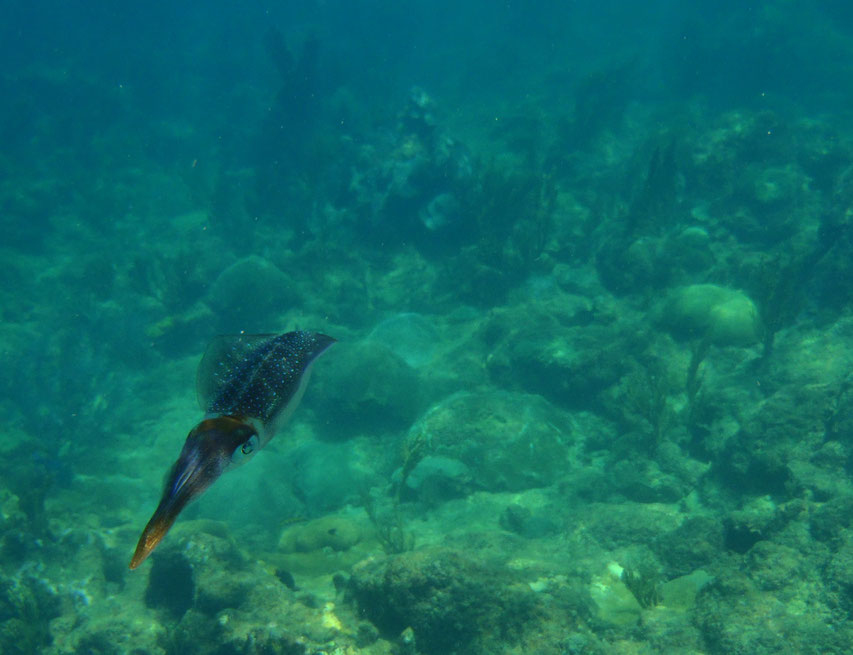
We were talking to Benny, a drunk Rastafarian man, down at Little Bay's beach bar one evening. He'd been rambling for a while, but Dan and I were tired and happy to let him do the talking, only interjecting with the occasional "oh wow". He likes living here in Castara as he grow his own food, catch his own fish and just enjoy living amongst "the Almighty's creation". Generally in this sort of situation it's a good idea to tell somebody how amazing their home is, but when Dan said that he lived in paradise, Benny got a little indignant. He'd travelled around a lot and said that this was only a small part of the work of the Almighty- "everywhere is paradise". I'm pretty sure he'd never been to my old home in Portswood, but having lived around Tobago all his life it's easy to see how he'd come to that conclusion.
Sun, smiles and coconut trees?
We met a mad woman at the bus station in Sangre Grande. Her pupils were enormous, obscured by a milky glaze which also covered the thin blue ring around them. Her faded greeny yellow dress and
decorated, but dirty, straw hat, along with her accent, implied that she'd once held a different position in society. The lady sat next to her moved to another bench.
She asked us what we were doing in Trinidad and told us (loudly, in a queue of Trinidadian people) that we should "exercise extreme caution" as we were not in a "civilised country". I was
worried that people would overhear and think I was agreeing, or worse had started the conversation, so told her that we'd actually found everyone to be very nice and helpful so far. She replied
in a patronising tone that I was suffering from the "sun, smiles and coconut trees syndrome"- we'd come from a cold country and were so dazzled that we thought we were in paradise, failing to
notice the corruption and criminality around us...
When her attention was diverted, some friendlier people around explained that she'd run away from hospital and that nobody wanted to sit next to her on the bus because of the smell. She got on our bus, causing some sort of commotion at the back, and I felt strangely disquieted until we'd got off and checked that she wasn't following. I don't think that she was dangerous, but the intensity of her cloudy stare made my skin crawl.
Trinidad: Immigration officials, a journey up North and a few days on the beach doing absolutely nothing.
I've never had any trouble getting through immigration before... We'd read somewhere that you 'might' be asked to provide proof of onward travel upon arrival in Trinidad, but thought that a bank statement and not looking like too much of a tramp should be enough. Unfortunately, we must have looked a little too much like illegal immigrants as after asking us a series of grilling questions, the stony faced lady behind the immigration desk asked us to walk back past the queue and wait on the plastic chairs o the far side of the room. We nervously watched everyone else filter through, sitting on the edge of our seats as she appeared to be having a cheerful natter with some of her colleagues. I couldn't imagine the embarrassment of having just said goodbye to my friends and family, hoping to go away for half a year or so, only to be sent back the next day after being refused entry into our first destination.
Architectural details of Marrakesh
I'm neither an architect nor a proper photographer, but I couldn't help but fall in love with these intricate designs. Click on the tiles below for full images...
Hitchhiking the Great Ocean Road...
|
|
| River by Allenvale Mile campsite. |
There are a variety of options if you want to see the Great Ocean Road. Obviously the ideal convenience choice would be to drive, but for those of us on the really frayed shoe-string budget, byeing or renting a car is pretty much out of the question. Hitchhiking on the other hand, is affordable (obviously) and unbelievably easy in this area- we barely had to wait more than ten minutes for a ride.

How to beg, borrow and steal* your way around Australia when all you have in your pocket is a collection of receipts and an old toothpick...
- Hitchhike- in case you hadn’t guessed I’m quite a fan…
- Make use of free campsites- you could pay $30 to stay in a crowded caravan park with a load of screaming kids OR you could pitch up in a nice, quiet spot by the beach for free. Admittedly some of the places we camped weren’t exactly designated spots, but if you are organised you could locate the legitimate ones on the internet, by asking in tourist offices or download the app ‘wiki camps’.
Sydney and its surroundings... a medley
So yes, it's been a bit manic, but we've found some fantastic places, all of which are fairly easily accessible from Sydney...
Hitchhiking in Australia- some Feathery tips...
These are obviously intended for novices and will probably otherwise come across as a bit patronising...
Melbourne, its Street Art and why it would be cool to live there…

Hitchhiking Sydney to Melbourne.
|
|
| Night 1- a horse field |
We're pretty happy about that!
As you can imagine, this lead to a few interesting situations over the course of journey- have a look at our route on my carefully crafted map at the bottom of this post.
Dapto itself was not an encouraging place to begin; most people looked at us as if we were clinically insane, some gestured wildly and one even swore at us out the window. Nevertheless we were picked up within half an hour and our first friendly driver took us twenty kilometers down the road- not a monumental start, but after our faffing in Sydney, it was already quite late by the time we arrived in Kiama.
|
|
| 6am, Kiama |
Debilitated by jetlag, heavy bags and indecisiveness, we trekked around and eventually out of the town until we were desperate enough to camp in an empty field, on a hill, right on top of a lumpy horse poo. With me being too cocky to bring a sleeping bag (it would be hot in Australia surely), Dan having lost his roll mat on the flight, a tent too short for him to lie flat in and both of us being to exhausted to get our stuff into any sort of organised state, that night was never going to go well. With the additional fear of being discovered and a river of condensation running freely off the sides of our tent, it was a disaster.
Consequently, we were up and packed by five am and on the road again by six. Unfortunately, we beat the cars and had to wait a while for our first ten kilometer lift down the road. The truck driver who finally picked us up did little to instill us with confidence...
Caqalai- my favourite place on Earth.
If you’re visiting Fiji on a budget, but want to escape the well-trodden, island-hopping backpacker trail, Caqalai (pronounced thang-a-lay) is a perfect alternative. This tiny island, situated just below Ovalau, has the relaxed feel of a tropical paradise without the hype.
Pol Pot, the Khmer Rouge and the Killing Fields.

